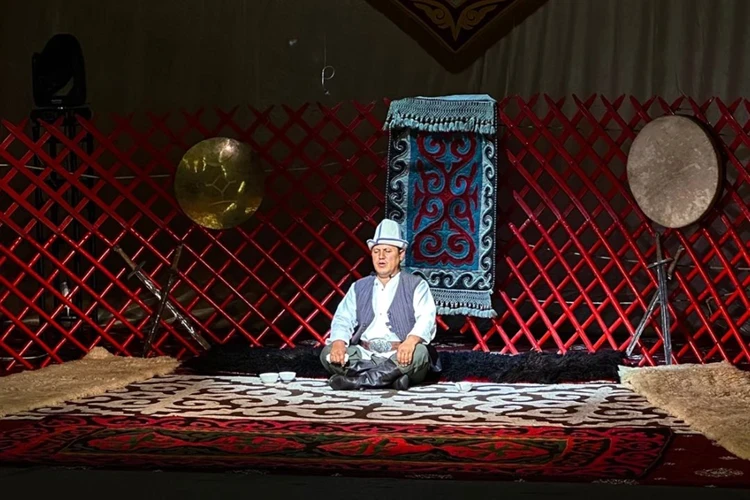
The study of ethnogenetic information of nomadic tribes has been significantly contributed to by...

In the mid-19th century, some influential manaps, realizing the significance of the sanjyr, began...

The sanjyra, as a historical source, consists of a structure made up of legendary and several...

Sanjiра is an oral chronicle that reflects the genealogical branches of individual clans, tribes,...

The analysis shows the continuity of historical and genealogical information in the sanjyra. A...

Genealogy is the “tree of life” of a person. The Turks, including the Kyrgyz, who, due to their...

In the sources, up until the 18th century, there is little information about the clan-tribal...

On March 13, a presentation of the collective monograph "Archaeological Sites on the Kyrgyz...

From October 18 to 22, the first republican competition 'Zharatman Manaschy' took place...

The traditional horseback game of kok-boru has been included in the representative list of...
Sydykov Nurbek Abdykalikovich has become the new deputy head of the Internal Affairs Department of...

Bernsham in the Popularization of the Epic "Manas" During the celebration of the...

The Buddha statue found in 2011 will be transferred to the Historical Museum by 2015. This was...

The strengthening of the socialist mode of production contributed to a consistent rise in the...

The family is the most important institution in the system of social relations in Kyrgyz society....

It is known that in the 18th century, the Kyrgyz, although rarely, used a new writing system, as...

In the national historical and archaeological museum complex "Sulaiman Too" in Osh,...

This year marks the conclusion of the cooperation project between Japan and Kyrgyzstan for the...

In mid-1985, under the initiative of M. S. Gorbachev, the course for perestroika was proclaimed in...

Kyrgyz journalism has gone through a rather fruitful, yet at the same time, a thorny path from the...

Belek Soltonoev Soltonkeldi Uulu (1878-1938) - historian, educator, writer, rightly recognized as...

Struggle for Power Among Individual Exploitative Groups With the overthrow of Tsarism (according...

Work on Restoring Historical Truth in Kyrgyzstan A certain shift in the study of our issue began...

Expeditions 1937-1940 at the Burana Settlement The difficulties of the recovery period in the...

The First Enlighteners: Ishenaly Arabayev, Ibraim Abdyrahmanov After Kyrgyzstan joined Russia,...

In November of this year, a joint nomination with Kazakhstan for "Traditional Knowledge of...

In a recent lecture by art historian Aina Moldokmatova at the Gapar Aitiev Museum of Fine Arts,...

Kyrgyzstan in the 1920s. Part - 3 With the beginning of perestroika and the proclamation of...
API error: no response...

Kyrgyz Division into Tribes and Clans Despite the absence of a centralized state, the Kyrgyz had...

The International Seminar "Preservation of Cultural Heritage in Central Asia" on the...

Zholbunov Nurbek Alymbekovich Artist - applied artist. Born on February 23, 1969, in the city of...

FEATURES OF HISTORICAL CONSCIOUSNESS AND SOCIAL BEHAVIOR OF THE KYRGYZ IN THE EARLY 20TH CENTURY...

The head of the International Historical and Archaeological Expedition at Issyk-Kul, Academician...

Among Kyrgyz women journalists and writers, the most popular name among readers, listeners, and...

IN MEMORY OF THE POET-PATRIOT BOKONBAEV In the late 1920s and early 1930s, Upper Street was the...

On the Path to Sovereignty and Independence: The Oath-Taking by Askar Akayev As part of the Soviet...

The Silk Road corridor in the Kyrgyz Republic has been included in the UNESCO World Heritage List....

As previously reported, on November 26, at the ninth session of the Intergovernmental Committee...

Traveling along the eastern part of the Issyk-Kul Lake coast, you will definitely find yourself in...

Tashravata Burial Grounds Materials from Kairagach are of great scientific value, as they help to...

Today, October 28, 2014, the President of the Kyrgyz Republic, Almazbek Atambayev, met with...

Turan Asia Boarding House Location: In the Bosteri resort area. Accommodation: In buildings, in...

New Research on the History of the Republic during the Great Patriotic War. A more comprehensive...

On December 12, a specialized shop will open at the National Historical and Archaeological Museum...

Ethnic Situation in the Tian Shan in the Middle Ages A comparative analysis of sources and early...
Kyrgyzstan is a country with a very ancient and rich culture and history. Among its cultural...

The Kyrgyz are one of the oldest peoples who lived in Central Asia and roamed the vast expanses of...